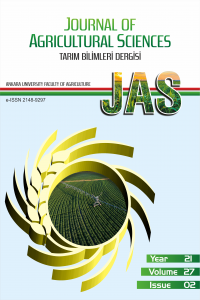Determination of green forage and silage protein degradability of some pea (Pisum sativum L.) + oat (Avena sativa L.) mixtures grown in Serbia
Determination of green forage and silage protein degradability of some pea (Pisum sativum L.) + oat (Avena sativa L.) mixtures grown in Serbia
Pea:Oat mixture, protein fractions, degradability,
- ISSN: 1300-7580
- Yayın Aralığı: Yılda 4 Sayı
- Başlangıç: 1995
- Yayıncı: Ankara Üniversitesi
Milomir Blagojević, Nenad Đorđević, Bora D, Jordan Marković, Tanja Vasić, Jamina Milenković, Mirjana Petrović
Mahmut Kaliber, İsmail Ülger, Selma BÜYÜKKILIÇ BEYZİ, Yusuf KONCA
Gamma rays and EMS induced Flower Color Mutation in Grasspea (Lathyrus sativus Linn.)
Pegah Ramezani, Morteza Siavoshi, Anil D More, Mahboubeh Ebrahimi
Agro-Morphological Variation Among an Ancient World Barley Collection
Filiz YANGILAR, Songul CAKMAKCİ
Some Technological and Functional Properties of Lactic Acid Bacteria Isolated from Hardaliye
Muhammet ARICI, Fatma COŞKUN, Gülnaz ÇELİKYURT, Mustafa MİRİK, Mehmet GÜLCÜ, Nazan TOKATLI
In Vitro Symbiotic Culture Studies of Some Orchid Species
Mehmet Emin Erdem, Serkan Koral, Sedef Işıdan
Gülsemin SAVAŞ TUNA, Gözde DUYU, Kardelen UZUN, Gülru YÜCEL, Metin TUNA
